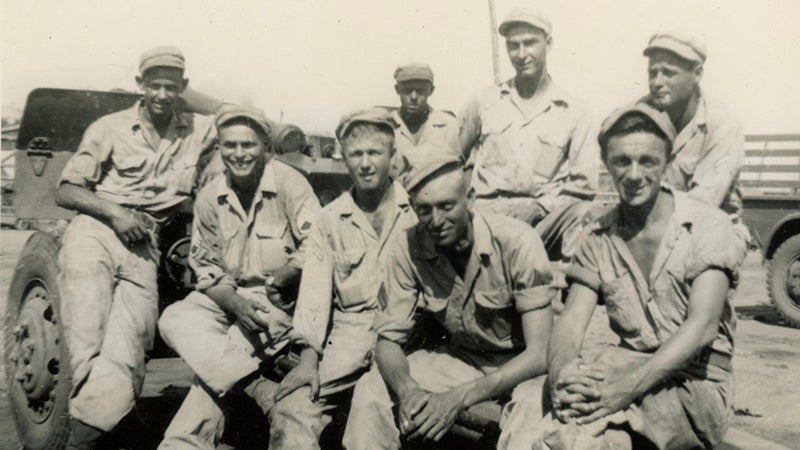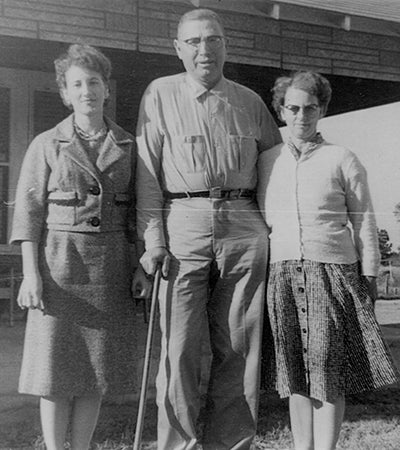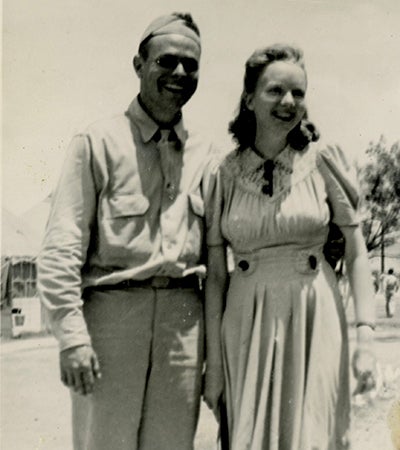COLUMN: Two Brothers from The Greatest Generation: Ira R. Hammett, Master Sergeant, U.S. Army, WWII, Marvin E. Hammett, Command Sergeant Major, U.S. Army, WWII
Published 1:00 pm Friday, November 10, 2023

- Marvin Hammett [second from left] and buddies in New Guinea during WWII.[Photo: Seth Hammett]
|
Getting your Trinity Audio player ready...
|
The Hammett brothers, Marvin and Ira, served together in the South Pacific during WW II. Ira had joined the 117th Field Artillery Battalion of the Alabama National Guard in Andalusia, Alabama, in June 1930. Marvin joined the same unit in 1933. They both were mobilized when the 117th was activated in November 1940, and sent to Camp Blanding, Florida, for training.

Post war photo of Ira Hammett and daughter Josephine [left] and wife Trudie Mae [right]. [Photo: Matthew Hammett]
Ira graduated from Straughn High School in 1929. Marvin quit high school in the 11th grade in 1932 to pursue an adventure with Ira and a family friend. In the midst of The Great Depression, the Hammett brothers and a friend decided that they were going to visit the World’s Fair in Chicago that was to take place in 1933.
They were going to travel in a vehicle they called a “skip jack.” In reality, the vehicle was nothing more than a motor and a frame. They tied planks to the frame to sit on. They tied a trunk to the rear to hold their clothes and used a box for the driver’s seat.
After leaving, they made it to north Alabama before running out of money. They were forced to stop and pick cotton for several weeks to earn enough money for food and gasoline to make it the rest of the way to Chicago. It had taken them a year but they made it to the World’s Fair. When they returned home, Ira and Marvin worked as farm hands and dump truck drivers. Ira married Trudie Mae Langford in 1935.Ira had joined the local National Guard unit in Andalusia in June 1930 and Marvin had joined in 1933. That local guard unit, the 117th Field Artillery Battalion was activated and sent to Camp Blanding, Florida, for training in November 1940. The 117th FAB became a part of the 31st Infantry Division, called the “Dixie Division” because it was mostly made up of men from several southern states.
The 117th FAB participated in field maneuvers in Louisiana and South Carolina before being divided in 1942. One element was re-designated as the 933rd FAB and deployed to North Africa. Marvin and Ira remained in Battery B of the 117th FAB and were transferred to Fort Hood, Texas, along with the remainder of the 31st Infantry Division.
While at Fort Hood, Ira and Marvin’s mother, along with Miss Mozelle Merrill came to visit. Marvin and Mozelle were married in March 1942.
The 31st Infantry Division was deployed from Fort Hood and arrived in Oro Bay, New Guinea, in April 1944. General Douglas MacArthur had devised a plan to bypass Japanese strongholds by making a series of landings on the coast of New Guinea. The 117th would follow the landing of troops on the beaches and set up supporting artillery fire as soon as they were ashore.
Ira and Marvin’s Battery B fired the 105mm howitzer. They participated in five of the landings in New Guinea. They sometimes set up their howitzer so close to the beach that they had to reposition the gun after each salvo because the gun carriage had been moved by the waves.
At one of the landing sites in New Guinea, Marvin’s firing position was next to a landing strip for B-25 bombers. The Army Air Corps was short of 50-caliber machine gunners and asked for volunteers who were qualified. Marvin was qualified and volunteered. He flew 10 missions aboard the B-25. At the end of the last mission, the volunteers were rewarded with a trip to Australia for some R & R. After they had landed in Australia, the pilot told them that someone would be back to bring them back but was unsure of the time. Marvin and the other volunteers refused to exit the plane and returned to New Guinea. They were afraid their unit might be moved and they might be separated. Marvin did not want to be separated from his brother and his unit.
The 31st Infantry Division invaded the island of Morotai in September 1944. The 117th followed the infantry and provided artillery support. The division also occupied several smaller islands including the Asia Islands; Sansapor, a part of Dutch New Guinea; and Mapia Atoll, part of the Freewill Islands. They met only light opposition since the Japanese had evacuated most of the islands in the area.
In April 1945, the 31st Division took part in the liberation of the Philippines when they invaded Mindanao. The 117th followed the infantry as they fought their way up the Sayre Highway and down the Kibawe-Talomo trail. The division fought through knee-deep mud caused by torrential rains. By the time Ira and Marvin landed on Mindanao, Ira had been made the First Sergeant of Battery B.
With the permission of the Battery Commander, the Hammett brothers would swap duties every couple of weeks. Whoever was First Sergeant would be responsible for the operations of Battery B, while the other had the duties of the Battery Sergeant, who was responsible for firing the guns.
When the war ended, both Hammett brothers returned home. They both had been awarded the Philippine Liberation Ribbon with Bronze Star, the Asiatic-Pacific Theater Ribbon with two Bronze Stars, the American Defense Services Ribbon and the Good Conduct Medal.
Marvin was employed as caretaker of the local National Guard Armory in Andalusia. He was working a dance at the armory when his son, Seth, was born.
Ira purchased a farm adjacent to his parents and row-cropped cotton, peanuts and corn. He also developed a large herd of beef cattle and owned poultry houses. Ira remained in the local Alabama National Guard unit until 1965.
In 1950, Marvin was reactivated and sent to Fort Jackson, South Carolina. His family lived with him on base during the one year he was there. When he was again discharged from active duty, he returned home and worked with Watson Drilling Company. He bought the company after a year and renamed it Hammett Drilling Company. He eventually sold half his interest to Richard Hammett in the 1970s. He sold the remainder of his interest to Richard and Matthew Hammett in 1999.
Marvin remained in the Alabama National Guard until he reached the mandatory retirement age of 60. He retired with the rate of Command Sergeant Major. His son, Seth, recalled his dad’s Monday night drills, his one weekend each month of training at Fort Rucker and his two-week summer camps at Fort Shelby, Mississippi. Seth said that his dad really loved the Army. He once asked his dad why he hadn’t made a career in the Army. His dad replied, “I couldn’t do that and live in Rose Hill.”
Ira Richard Hammett died March 13, 1991. His funeral was held at Foreman Funeral Chapel with burial with full military honors at Macedonia Cemetery in the Rose Hill community. He was survived by a sister, Susan Clyde Hammett Straughn; a brother Marvin Eugene Hammett; two daughters, Linda Hammett and Josephine Hammett Ray; and two sons, Billy Hugh Hammett and Richard Hammett; and one grandson, Richard Matthew Hammett.
Marvin Eugene Hammett died October 7, 2010. His funeral was held at Foreman Funeral Home Chapel with burial with full military Honors at Macedonia Cemetery in the Rose Hill community. He was survived by his wife, Mozelle Hammett; his son Seth Merrill [Nancy] Hammett; two daughters, Carolyn Hammett [Rayford] Davis, Joan Hammett [Rex] Russell; grandchildren, Terri Davis Wilson, Dwain Merrill Davis, Debbie Davis Posey, Jo Lynn Cox, Seth Merrill Hammett, Jr. and Catherine Carmack Hammett; and seven great-grandchildren.
John Vick
The author would like to thank Seth Hammett and Matthew Hammett for their help in telling the Hammett brothers’ story.
{Sources: Wikipedia, The Encyclopedia of Alabama]






